Day 4: Basic Poses
The Cartoon Skeleton
Every face, head, body or pose is constructed on the basis of a skeleton. Just like the real human body our drawing is going to stand or fall depending upon the sturdiness of it’s skeleton or basic underlying structure.
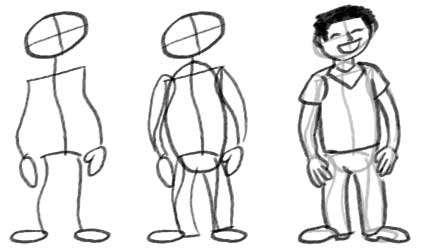
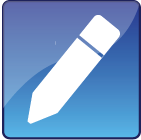 The idea of constructing a pose that is not in front of you as most of the time your subject will be seated, is a daunting task for most novice artists. Don’t worry we are going to show you how to overcome your fears by a few simple tricks that are based on the drawing “skeleton” that will guarantee you can’t go wrong. So grab your tracing paper and do the above simple 3 step sketch.
The idea of constructing a pose that is not in front of you as most of the time your subject will be seated, is a daunting task for most novice artists. Don’t worry we are going to show you how to overcome your fears by a few simple tricks that are based on the drawing “skeleton” that will guarantee you can’t go wrong. So grab your tracing paper and do the above simple 3 step sketch.
When you get used to drawing these simple poses you will no longer have to draw a skeleton first but that will be done the track when you feel confident that your sketches will do the trick.
Also we will show you how to practice and make perfect simple little skeletons first before putting on any flesh or clothes.
The biggest mistake that the novice artist makes is to skip this vital step. In so doing they are missing the point of the cartoon pose, “Gesture”.
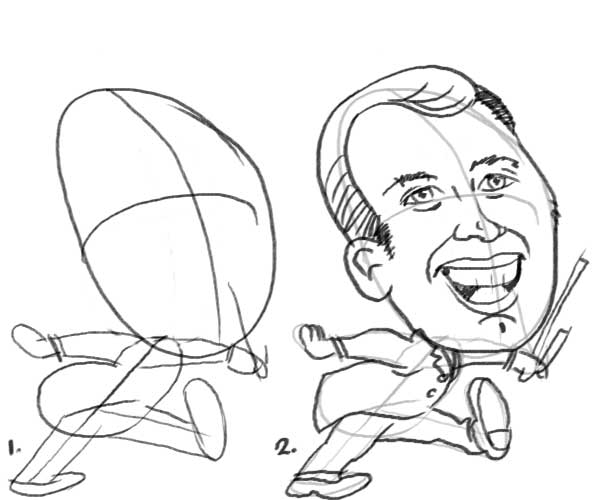 Each little skeleton that you draw will have a suggested feeling or projected emotion that at the heart of the matter is a simple “gesture”.
Each little skeleton that you draw will have a suggested feeling or projected emotion that at the heart of the matter is a simple “gesture”.
Take a look at the above two-step gesture based cartoon. Notice that you can really read the emotion of the sketch in step1. If you never saw (the rough sketchy) step 2, you would probably understand that this was cartoon of man in a bold stride.
- You would know from this that he is not depressed.
- You would know that he is not sneaking or acting shy.
- You could probably guess he was having fun.
- The one thing that is missing is the facial expression.
Now the only thing apart from the loose details of the clothing that has been added, is the face detail and expression. This man is happy, he is in a dashing stride, maybe he has just won a fortune or maybe he is in Broadway production. To let people in on the gag completely you simply add in some background elements.
So lets take a look at two different sets of background elements that will do just that.
The first image is going to show you the same man with a background suggesting he has won a fortune, the second one unchanged apart from the background again, the man looks like he is part of a Broadway production.
 Fig 1. “I’ve just won a fortune”!
Fig 1. “I’ve just won a fortune”!
 Fig 2. “I’m in a Broadway production!
Fig 2. “I’m in a Broadway production!
So this is a very important thing to remember, if you get your set lot of poses practice and rehearsed well, then it will be a simple matter of deciding which one you will choose to “attach” to your “big head”.
Remember, Graeme’s style of “big head – facing straight ahead”, can be used in literally dozens of pose types:
- sitting
- standing
- dancing
- running
- walking
- riding
- jumping
- flying
- landing
- sneaking
- strutting
- falling
Now if you had the person doing a side-on or 3/4 view, you will be limited with your set poses as to how to make them work easily.
Happy Smiling Faces
So it comes down to the gesture or pose and the expression on their faces. Now most of the time the expression is NOT going to change. Everyone loves to see themselves smiling when they look in the mirror and the caricature is a mirror type expression of someone, so happy smiling is what you are going to do most of the time.
Body language is all about the gesture. Lets look at the following examples of stick (skeleton) men.
Can you pick which one is:
1.Falling
2.Sprinting
3.Creeping
4.Golf Swing
5.Horse Ridding
6.Twisting
7.Flying
8.Football Run
9.Sitting
10.Walking
11.Standing
12.Skiing
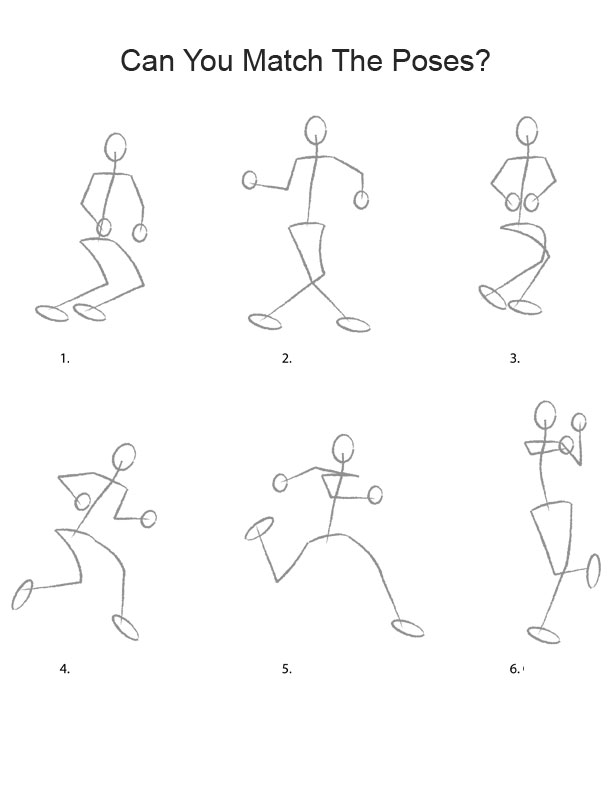
Which pose is which?
See if you can match up the sprinter, the golf swing, the creeper, the dancer, the sitter, the twister, the skier, the faller, the horse rider, the stander.
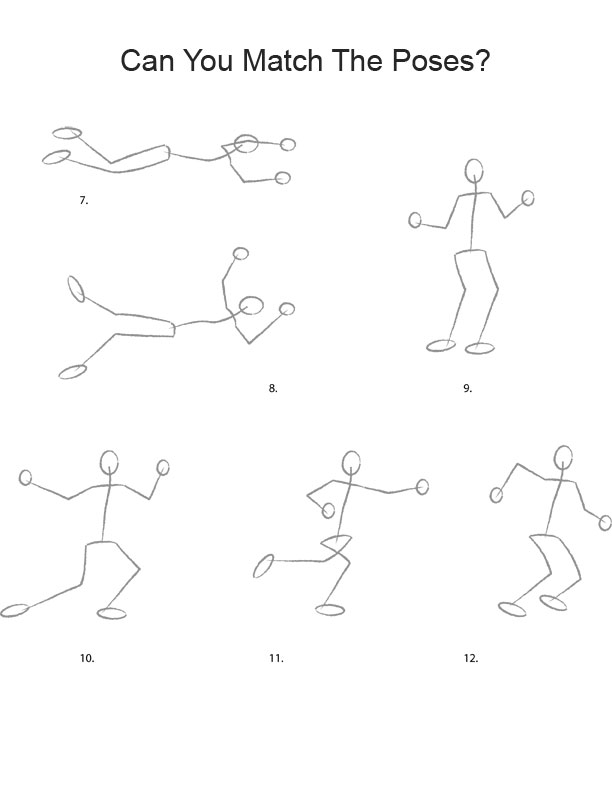 See if you can match up the skier, the dancer, the football runner, the faller, the stander, the flyer.
See if you can match up the skier, the dancer, the football runner, the faller, the stander, the flyer.
So How Did You Go?
Now scroll down to see how you went with matching the poses. It shouldn’t have been too difficult.
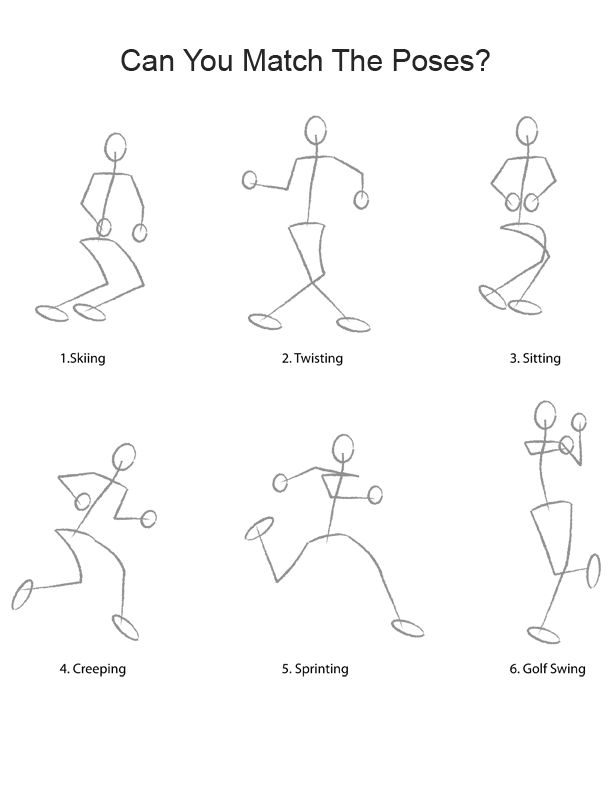
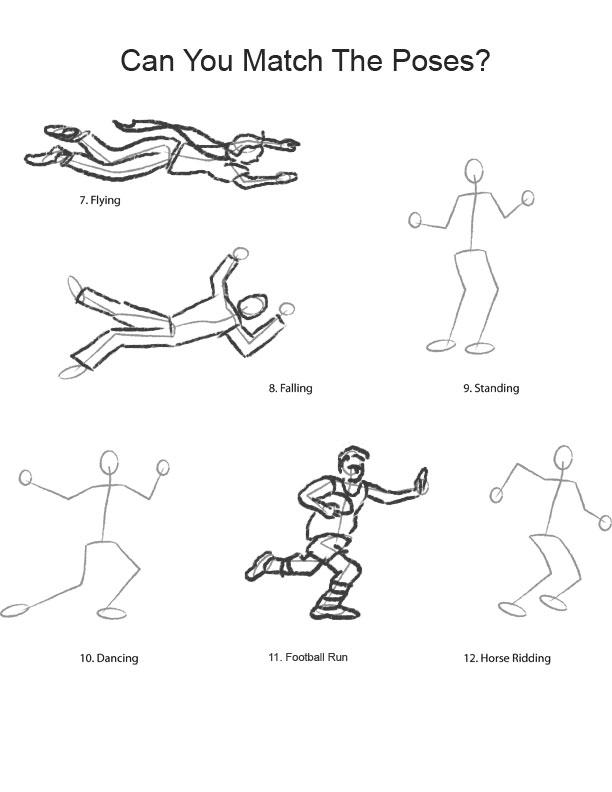
This goes to show how the essence of the gesture is contained in the skeleton of the character. This is the fun container, that you put the rest of the caricature into, so that when matched with a fun facial expression and some background elements you have your completed scene.
Now It’s Your Turn
 Print the above images and trace them off to get a feel for the simplicity of their construction. Study the proportions carefully and then try to do this freehand. You can come up with as many different poses as you like.
Print the above images and trace them off to get a feel for the simplicity of their construction. Study the proportions carefully and then try to do this freehand. You can come up with as many different poses as you like.
Practice this exercise on a daily basis from here on to the end of the 7 days to get your poses in the flow of your artistic hand.
Simple Shapes To Success
Every pose can be constructed this way. A simple shape first.
You can draw simple shapes without much difficulty right? Of course you can.
So each of these poses that start with a skeleton are now covered with a simple shape. Box – square or oblong, oval – circular or ellipsoid, triangle – tall or squat.
So now dress up the skeletons with some form and see how easy it is to bring them to life.
Begin by simple box shapes, then, with a pen flesh it out.
 Read Me: Keep it loose and enjoy the Freedom
Read Me: Keep it loose and enjoy the Freedom
Do take special note of just how loose and free and easy this final stage is. These exercises form the basis of pose training for our caricatures when we get to the next stage. It is important to know the basic proportions first, like these examples we have just completed, before we can move to the “big head – small body” distortion of a caricature.
Get the gesture right with that simple skeleton and shape trick and the rest is assured to capture the emotion and fun intended in your drawing.
![baby_rod heard[M]](http://learn-to-draw.org/wp-content/uploads/2015/09/baby_rod-heardM.jpg) Have a look at this color caricature and notice the “lack” of detail on the baby’s hand, hardly any indication of fingers but the drawing still works because of the skeleton (gesture) and simple shapes for clothes.
Have a look at this color caricature and notice the “lack” of detail on the baby’s hand, hardly any indication of fingers but the drawing still works because of the skeleton (gesture) and simple shapes for clothes.
Spend time practicing these quick little poses by studying other cartoons such as Tom and Gerry, Bugs Bunny and any of the Disney® characters. You can find more books on cartooning on Amazon by clicking Amazon Art Books.

